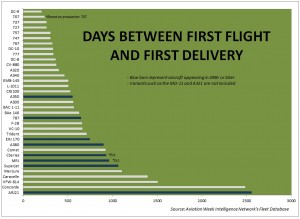Peter Lobner
After designing, developing, and manufacturing a new commercial airliner, I’m sure the airframe manufacturer has a big celebration on the occasion of the first flight. The ensuing flight test and ground static test programs are intended to validate the design, operating envelope, and maintenance practices and satisfy these and other requirements of the national certifying body, which in the U.S. is the Federal Aviation Administration (FAA). Meanwhile, airlines that have ordered the new aircraft are planning for its timely delivery and introduction into scheduled revenue service.
The time between first flight and first delivery of a new commercial airliner is not a set period of time. As you can see in the following chart, which was prepared by Brian Bostick (http://aviationweek.com/thingswithwings), there is great variability in the time it takes to get an airliner certified and delivered.
In this chart, the Douglas DC-9 has the record for the shortest certification period (205 days) with certification in November 1965. The technologically advanced supersonic Concorde had one of the longest certification periods (almost 2,500 days), with authorization in February 1976 to conduct a 16-month demonstration period with flights between Europe and the U.S. before starting regular commercial service.
The record for the longest certification period goes to the Chinese Comac ARJ21 twin-jet airliner, which is the first indigenous airliner produced in China. The first ARJ21 was delivered to a Chinese airline in November 2015. The ARJ is based on the DC-9 and reuses tooling provided by McDonnell Douglas for the licensed production of the MD-80 (a DC-9 variant) in China. I suspect that the very long certification period is a measure of the difficulty in establishing the complete aeronautical infrastructure needed to deliver an indigenous commercial airliner with an indigenous jet engine.
In the chart, compare the certification times for the following similar commercial airliners:
- Four-engine, single aisle, long-range airliners: Boeing 707 (shortest), Douglas DC-8, Convair CV-880, Vickers VC-10, De Havilland Comet (longest)
- Three-engine, single aisle, medium range airliners: Boeing 727 (shorter), Hawker Siddeley Trident (longer)
- Two-engine, single aisle airliners: Douglas DC-9 (shortest), Boeing 737, Boeing 757, Airbus A320, British Aircraft Corporation BAC 1-11, Dassault Mercure, Caravelle (longest)
- Two-engine, single aisle, short range regional jets: Embraer ERJ 145 (shortest), Bombardier CRJ-100, BAe 146, Fokker F-28, ERJ 170, Bombardier CS Series, Mitsubishi MRJ, Sukhoi Superjet, VFW-614, Comac ARJ21 (longest)
- Four-engine, wide-body, long-range airliners: Boeing 747, Airbus A340, Airbus A380 (longest)
- Three-engine, wide-body, long-range airliners: Douglas DC-10 (shorter), Lockheed L-1011 (longer)
- Two-engine, wide-body airliners: Boeing 767 (shortest), Boeing 777, Airbus 350, Airbus A300, Boeing 787 (longest)
Time is money, so there is tremendous economic value in minimizing the time between first flight and first delivery. The first 16 aircraft at the top of the chart all enjoyed relatively short certification periods. This group, which includes many aircraft that appeared in the 1960s – 70, averaged about 400 days between first flight and first delivery.
More modern aircraft (blue bars in the chart representing aircraft appearing in 2000 or later) have been averaging about 800 days between first flight and first delivery (excluding ARJ21).
